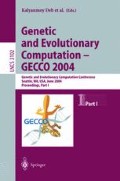Abstract
Aligning multiple DNA or protein sequences is a fundamental step in the analyses of phylogeny, homology and molecular structure. Heuristic algorithms are applied because optimal multiple sequence alignment is prohibitively expensive. Heuristic alignment algorithms represent a practical trade-off between speed and accuracy, but they can be improved. We present EVALYN (EVolved ALYNments), a novel approach to multiple sequence alignment in which sequences are progressively aligned based on a guide tree optimized by a genetic algorithm. We hypothesize that a genetic algorithm can find better guide trees than traditional, deterministic clustering algorithms. We compare our novel evolutionary approach to CLUSTAL W and find that EVALYN performs consistently and significantly better as measured by a common alignment scoring technique. Additionally, we hypothesize that evolutionary guide tree optimization is inherently efficient and has less time complexity than the commonly-used neighbor-joining algorithm. We present a compelling analysis in support of this scalability hypothesis.
Access this chapter
Tax calculation will be finalised at checkout
Purchases are for personal use only
Preview
Unable to display preview. Download preview PDF.
References
Needleman, S.B., Wunsch, C.D.: A general method applicable to the search for similarities in the amino acid sequences of two proteins. Journal of Molecular Biology 48(3), 443–453 (1970)
Smith, T.F., Waterman, M.S.: Identification of Common Molecular Subsequences. Journal of Molecular Biology 48, 443–453 (1981)
Just, W.: Computational Complexity of Multiple Sequence Alignment with SP-Score. Journal of Computational Biology 8(6), 615–623 (2001)
Notredame, C.: Recent progresses in multiple sequence alignment: a survey. Pharmacogenomics 3(1) (2002)
Saitou, N., Nei, M.: The neighbor-joining method: A new method for reconstructing phylogenetic trees. Molecular Biology Evolution 4, 406–425 (1987)
Notredame, C., Higgins, D.G.: SAGA: sequence alignment by genetic algorithm. Nucleic Acids Research 24(8), 1515–1524 (1996)
Carillo, H., Lipman, D.: The multiple sequence alignment problem in biology. SIAM Journal on Applied Mathematics 48(5), 1073–1082 (1988)
Thomsen, R., Fogel, G.B., Krink, T.: A Clustal alignment improver using evolutionary algorithms. In: Congress on Evolutionary Computation (CEC), Honolulu, Hawaii (2002)
Higgins, D.G., Bleasby, A.J., Fuchs, R.: CLUSTAL V: improved software for multiple sequence alignment. Comput. Appl. Biosci. 8(2), 189–191 (1992)
Lewis, P.O.: A genetic algorithm for maximum-likelihood phylogeny inference using nucleotide sequence data. Molecular Biology Evolution 15(3), 277–283 (1998)
Matsuda, H.: Protein phylogenetic inference using maximum likelihood with a genetic algorithm. In: Pacific Symposium on Biocomputing, World Scientific, London (1996)
Congdon, C.B.: Gaphyl: An Evolutionary Algorithms Approach for the Study of Natural Evolution. In: Genetic Evolutionary Computation Confernece (GECCO), Morgan Kaufmann, San Francisco (2002)
Fitch, W.M.: Toward defining the course of evolution: Minimum change for a specific tree topology. Systematic Zoology 20, 406–416 (1971)
Koza, J.: Genetic Programming: On the Programming of Computers by Means of Natural Selection. MIT Press, Cambridge (1992)
Soule, T., Foster, J.A.: Effects of code growth and parsimony pressure on populations in genetic programming. Evolutionary Computation 6(4), 293–309 (1998)
Dayhoff, M.O., Schwartz, R.M., Orcutt, B.C.: A model of evolutionary change in proteins. Atlas of Protein Sequence and Structure (1978)
Henikoff, S., Henikoff, J.G.: Amino acid substitution matrices from protein blocks. National Academy of Sciences of the USA (1992)
Howe, K., Bateman, A., Durbin, R.: QuickTree: building huge Neighbor-Joining trees of protein sequences. Bioinformatics 18(11), 1546–1547 (2002)
Thompson, J.D., Higgins, D.G., Gibson, T.J.: CLUSTAL W: improving the sensitivity of progressive multiple sequence alignment through sequence weighting, position-specific gap penalties and weight matrix choice. Nucleic Acids Research 22(22), 4673–4680 (1994)
Jukes, T.H., Cantor, C.R.: Evolution of protein molecules. In: Munro, H.N. (ed.) Mammalian Protein Metabolism, pp. 21–132. Academic Press, London (1969)
Thompson, J.D., Plewniak, F., Poch, O.: BAliBASE: A benchmark alignments database for the evaluation of multiple sequence alignment programs. Nucleic Acids Research 27(13), 2682–2690 (1999)
Felsenstein, J.: Evolutionary trees from DNA sequences: A maximum likelihood approach. Journal of Molecular Evolution 17, 368–376 (1981)
Author information
Authors and Affiliations
Editor information
Editors and Affiliations
Rights and permissions
Copyright information
© 2004 Springer-Verlag Berlin Heidelberg
About this paper
Cite this paper
Sheneman, L., Foster, J.A. (2004). Evolving Better Multiple Sequence Alignments. In: Deb, K. (eds) Genetic and Evolutionary Computation – GECCO 2004. GECCO 2004. Lecture Notes in Computer Science, vol 3102. Springer, Berlin, Heidelberg. https://doi.org/10.1007/978-3-540-24854-5_45
Download citation
DOI: https://doi.org/10.1007/978-3-540-24854-5_45
Publisher Name: Springer, Berlin, Heidelberg
Print ISBN: 978-3-540-22344-3
Online ISBN: 978-3-540-24854-5
eBook Packages: Springer Book Archive

